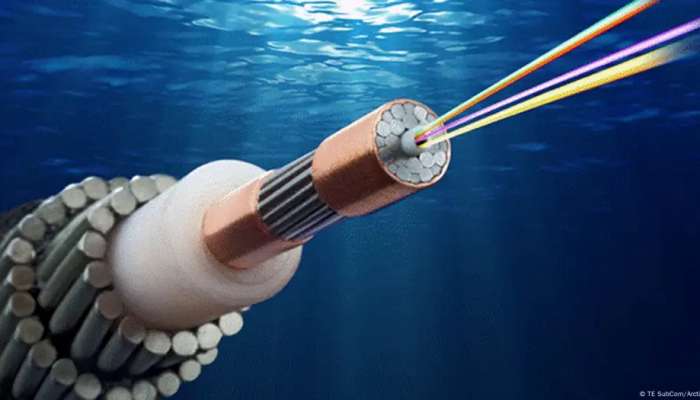
Frankfurt: A spate of sabotage attacks on underwater cables, allegedly perpetrated by a Russian "shadow fleet," have shown global telecommunications infrastructure is poorly protected against deliberate acts of destruction.
Different types of underwater cables
Some submarine cables transport high-voltage direct current (HVDC), electrical energy, over long distances, such as between islands or countries. These cables can also connect offshore wind turbines with onshore sites.
Then there are telecommunications cables. They transmit about 95% of global data traffic, including internet searches, online shopping and phone calls — albeit with a slight signal delay, as calling up a US website from Europe takes around 60 milliseconds.
In addition, some cables link data centers and large network nodes, as well as those for military communication and research, which are more protected than other cables.
Satellites are not an alternative to underwater cables
Only a fraction of international communication goes via satellites. Submarine cables can transmit much more data at a lower cost.
Satellite connections are slower and more susceptible to interference.
Nevertheless, the US and the EU are investing in satellite technologies, such as Starlink and the IRIS (Infrastructure for Resilience, Interconnectivity and Security by Satellite) program, to create more secure, alternative communication channels.
Where do underwater cables lie?
Worldwide, there are about 500 cable lines consisting of 1.4 million kilometers of cable. The cables are so long that they could be wrapped around the equator 30 times. New cables are added every year.
Most cable connections are located in the Atlantic between Europe and North America and in the Pacific between the US and East Asia. However, no complete global atlas shows the exact location of every cable.
Platforms such as submarinecablemap.com or TeleGeography offer maps, but without precise location information.
About 90% of data traffic between Europe and Asia runs via 14 cables off the Yemeni coast. In 2024, Houthi rebels attacked three data lines with a hijacked freighter in the region.
Who lays underwater cables?
In the past, telecom service providers, such as AT&T and China Telecom, dominated the market and ownership of submarine cables.
Now, it's the big tech companies like Google, Microsoft, Meta and Amazon investing heavily in submarine cables.
Google owns six active submarine cables and plans to build more.
Meta has a stake in 16 existing cables and plans to make its own global network.
How are underwater cables constructed?
Modern submarine cables consist of several layers of fiber optics that use light pulses to transmit digital information.
They are surrounded by protective layers of steel wire or steel armor, polyethylene and waterproof materials. These protect against the extreme pressure and conditions of the deep sea and ensure a lifespan of about 25 years.
Large submarine cables with a diameter of more than 20cm (7.87 inches) can weigh between 40-70 kilograms per metre (88-154 pounds/3.2 feet).
How are underwater cables laid?
Geologists and engineers determine the best locations for cables, considering obstacles such as trenches, ocean currents, fishing areas and shipping routes.
In the North and Baltic Seas, around 1.6 million tons of dumped ammunition from past wars also pose a significant challenge.
In deeper waters, up to about eight kilometers, the risk of damage is lower. The cables are often laid directly on the seabed by special cable-laying vessels.
The cable has to be taut during the laying process. If there is too little tension, loops might form in the cable. However, if the cable is too taut, it can make it float and break.
How do underwater cables get damaged?
Trawl nets and anchors cause most damage to submarine cables. But they are also damaged through deliberate acts of sabotage: Hybrid warfare attacks have been known since the Cold War. As early as 1959, the Americans accused the Russians of deliberately damaging an underwater cable with fishing nets.
Espionage is also a big problem, as submarine cables can be tapped for data.
How are underwater cables repaired?
Repairing submarine cables is complicated due to extreme underwater pressure and unpredictable weather conditions.
Depending on the damage and depth of the cable, divers can repair cables in dry chambers, or a cable repair ship can carefully lift them to the surface.
On board, technicians replace damaged sections with new ones. After extensive testing, the cable is carefully recessed and laid again.
How can underwater cables be protected?
Submarine cables are well protected against natural threats but are often inadequately protected against deliberate damage by hostile states, intelligence agencies or terrorists.
Underwater drones and acoustic sensor systems could help to detect potential acts of sabotage at an early stage.
Some states are developing coordinated protection strategies, with close cooperation between the states, submarine cable operators and international organisations. Experts are calling for a new legal framework at national and international levels, especially in the event of war.